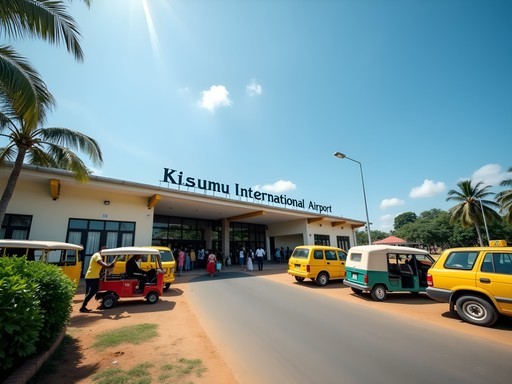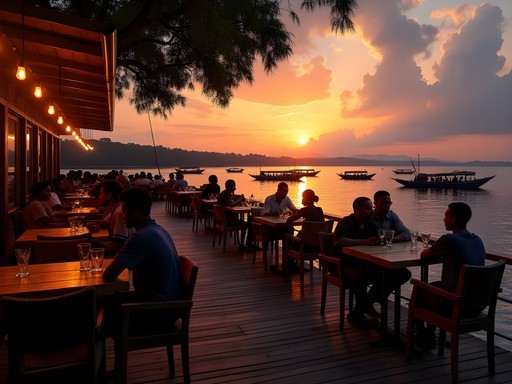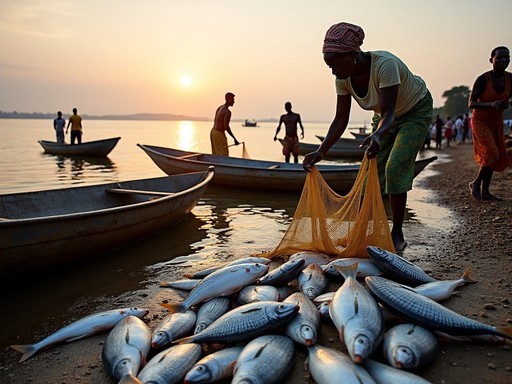Disclosure: This article contains affiliate links. We may earn a commission from purchases at no extra cost to you, which helps our travel content.
The rhythmic hum of tuk-tuk engines and the colorful blur of matatus weaving through traffic greeted me as I stepped out of Kisumu International Airport last spring. This wasn't my first rodeo in East Africa, but Kisumu—Kenya's third-largest city nestled along the shores of Lake Victoria—has its own distinct pulse and flow. I'd come to Kenya's western hub to volunteer with a water access project, but also to scout the legendary Kisumu Marathon route that winds past the lake's shimmering waters. What I discovered was a transportation ecosystem as vibrant and layered as the city itself—one that reveals Kisumu's soul if you're willing to move through it mindfully. Whether you're a solo traveler looking to explore this lakeside gem on a budget or seeking authentic connections beyond the typical tourist path, understanding how to navigate Kisumu's transportation options is your first step toward experiencing the city's true heartbeat.
Airport Arrivals: Your First Steps in Kisumu
Kisumu International Airport (KIS) sits just 5.5 kilometers southwest of the city center—close enough that you can practically feel the lake breeze from the tarmac. After collecting my backpack from the modest baggage claim area, I stepped outside to find the usual cluster of taxi drivers calling out for business.
Unlike Nairobi's highly organized airport transportation system, Kisumu's is refreshingly straightforward but requires some savvy navigation. Official airport taxis charge around 1,000-1,500 KSH ($7-10) to the city center, but I've found you can negotiate down to about 800 KSH if you're patient and friendly. Before leaving home, I downloaded the Offline Maps to my phone, which proved invaluable for confirming routes without burning through my data plan.
If you're feeling adventurous and traveling light, walk about 500 meters from the terminal to the main road where you can flag down a matatu (minibus) for just 50 KSH ($0.35) into town. This option isn't advertised to tourists, but it's perfectly safe during daylight hours and offers an immediate immersion into local life. The matatus heading to the city center are usually marked 'Kisumu CBD' or 'Kisumu Town.'
One thing I've learned through years of arrival rituals in new cities: take a moment to center yourself before diving into transportation negotiations. The same breathing technique I use at marathon starting lines works wonders here—three deep breaths, a moment of gratitude, then engage with clear intention.

💡 Pro Tips
- Pre-download an offline map app before arrival to avoid data charges
- Have small Kenyan Shilling notes ready for easier negotiations
- Ask your accommodation to arrange airport pickup if arriving after dark
Boda Bodas: The Heartbeat of Kisumu's Streets
If Kisumu had a soundtrack, the distinctive puttering of motorcycle taxis—locally known as boda bodas—would be its baseline rhythm. These nimble two-wheelers are everywhere, piloted by drivers in colorful reflective vests who can navigate through traffic jams that would leave cars stranded for hours.
During my week exploring Kisumu, boda bodas became my primary mode of transportation. A typical ride within the city center costs between 50-150 KSH ($0.35-1.00), while trips to outlying areas like Dunga Beach or Kit Mikayi might run 200-400 KSH ($1.40-2.80). The price flexibility reflects the Kenyan negotiation culture—always agree on your fare before hopping on.
Safety considerations here are real but manageable. I always travel with my portable helmet that compresses to fit in my daypack. While it raised a few curious eyebrows from locals, several drivers actually commented on how smart it was. Helmet use isn't common among locals, but as a foreigner, it's a precaution worth taking.
One morning, I needed to reach Dunga Beach for sunrise to capture the fishermen launching their boats. My boda driver, Francis, not only got me there safely in the pre-dawn darkness but ended up introducing me to his brother who ran a small fish processing operation—an authentic connection I'd never have made otherwise. This is the magic of boda transportation—it's not just about getting from A to B, but about the human connections formed along the way.
Remember that boda drivers often know the city better than any guidebook. When I mentioned wanting to find a specific record shop that carried Benga music (the regional guitar-based style born near Kisumu), my driver took me directly to a hidden gem that wasn't on any tourist map. These moments of serendipity are what make boda transportation in Kisumu so much more than just a practical choice.

💡 Pro Tips
- Always negotiate your boda boda fare before starting your journey
- Consider bringing your own helmet for safety
- Save trusted drivers' phone numbers for reliable transportation throughout your stay
Matatus & City Buses: Decoding Kisumu's Public Transit
Matatus—Kenya's iconic privately-owned minibuses—are moving cultural exhibits wrapped in colorful art, pulsing music, and the organized chaos that defines East African public transportation. In Kisumu, these 14-seater vans operate on semi-fixed routes that connect major neighborhoods and surrounding towns.
My first matatu experience in Kisumu came when visiting the sprawling Kibuye Market on the city's western edge. Standing at the central bus stage (station) near Jomo Kenyatta Highway, I watched matatus come and go, each with a tout hanging from the door shouting destinations. Unlike the regimented bus systems we're accustomed to in Toronto, matatus operate on the fill-and-go principle—they depart when full, not on a fixed schedule.
Navigating this system requires some local knowledge. Matatus display their destinations on the front windshield, but routes are known by landmarks rather than numbers. Fares are standardized by distance, typically ranging from 30-100 KSH ($0.20-0.70) within the city. Payment is made to the conductor during the journey, so keep small bills handy.
For those seeking more structure, Kisumu also has larger city buses operated by the Nyanza Bus Company that run on more predictable schedules. These are slightly more expensive than matatus (starting around 50 KSH) but offer a more comfortable ride without the blaring music and aggressive driving sometimes found on matatus.
During my stay, I discovered that the sweet spot for matatu travel is mid-morning (9-11am) and mid-afternoon (2-4pm), when they're neither too crowded nor stuck in rush hour traffic. This timing allowed me to practice what I think of as 'moving meditation'—observing local life through the window while listening to the distinctive Luo language conversations around me.
One particularly memorable matatu ride took me to Ahero, a town about 25km east of Kisumu, where I'd heard about a monastery with an impressive collection of traditional musical instruments. The journey itself became part of the experience—watching the landscape transition from urban to rural while sharing space with locals carrying everything from live chickens to enormous bags of rice.

💡 Pro Tips
- Learn a few basic Swahili phrases like 'Nataka kwenda...' (I want to go to...)
- Keep your valuables secure in crowded matatus
- Ask locals which matatu serves your destination rather than trying to decipher the system alone
Tuk-Tuks: The Middle-Ground Option
In the hierarchy of Kisumu transportation, tuk-tuks occupy that sweet middle ground—more comfortable than boda bodas but more nimble than taxis. These three-wheeled auto rickshaws, painted in vibrant yellows and blues, zip through Kisumu's streets with a distinctive buzzing sound that becomes part of the city's ambient soundtrack.
For solo travelers concerned about safety or comfort, tuk-tuks offer an excellent compromise. They typically cost 100-300 KSH ($0.70-2.10) for trips within the city center—slightly more expensive than bodas but considerably cheaper than taxis. The semi-enclosed design provides some protection from sun and rain while still allowing you to feel connected to the street life flowing past.
During one particularly intense afternoon downpour, I was grateful for my waterproof phone pouch that kept my device dry while navigating from the Kisumu Museum back to my guesthouse. The tuk-tuk's canvas sides were little match for the horizontal rain, but my phone and passport stayed perfectly dry.
Tuk-tuk drivers in Kisumu tend to be characters—often more talkative than boda drivers and full of local insights. My driver Joseph became an unofficial guide during my stay, suggesting I visit Hippo Point at sunset rather than midday when most tourists go. His recommendation led to one of my most peaceful moments in Kisumu—watching hippos emerge while the sun painted Lake Victoria in shades of orange and pink.
One navigation tip I discovered: tuk-tuks are particularly useful for exploring Kisumu's central business district and the lakefront areas, where traffic congestion makes them faster than cars but safety concerns might make bodas less appealing. They're also ideal for short shopping trips, as you can easily store bags beside you—something I appreciated after visiting Kibuye Market with my haul of local coffee beans and handcrafted beaded bracelets.

💡 Pro Tips
- Tuk-tuks are excellent during rain showers when bodas would leave you soaked
- For shopping trips, tuk-tuks offer more space for bags than boda bodas
- Ask your accommodation for the typical price range to common destinations to avoid overpaying
Lake Victoria Transportation: Ferries & Fishing Boats
No transportation guide to Kisumu would be complete without addressing the watery highways of Lake Victoria. The lake isn't just a scenic backdrop—it's a crucial transportation corridor connecting Kisumu to islands and shoreline communities that rely on water transport for their economic survival.
The MV Uhuru ferry remains the largest commercial vessel operating from Kisumu Port, though service schedules can be irregular. For travelers, smaller passenger boats offer more accessible lake experiences. A trip to nearby Ndere Island National Park costs around 2,000-3,000 KSH ($14-21) for a boat rental, though this price is negotiable if you join other travelers.
My most authentic lake transportation experience came through a connection at my guesthouse, who introduced me to Otieno, a fisherman heading to Mfangano Island. For 1,000 KSH ($7), I joined his early morning journey, helping cast nets while learning about the lake's environmental challenges and spiritual significance to the Luo people. We departed from the small Dunga Beach fishing village rather than the main port—a reminder that sometimes the most meaningful transportation experiences happen outside official channels.
Before any lake journey, I made sure my essentials were protected in a dry bag that kept my camera and journal safe from spray and unexpected rain showers. The lake's conditions can change quickly, so waterproofing valuables is non-negotiable.
Running along the shores of Lake Victoria at sunrise became a daily ritual during my stay, a moving meditation that connected me to both the physical landscape and the rhythms of local life. Fishermen preparing their boats, market vendors setting up, and school children in crisp uniforms all became familiar sights along my route. This daily practice—covering 5-7km each morning—revealed a Kisumu that many visitors miss by relying solely on motorized transportation.
For those planning day trips to the islands, remember that boat schedules are more suggestion than certainty. The lake transportation system operates on 'Africa time'—a reminder to release rigid expectations and embrace the natural flow of life here. Some of my richest conversations happened while waiting for boats that arrived hours later than planned.

💡 Pro Tips
- Always wear a life jacket during lake crossings, even if locals don't
- Negotiate boat fares before departure, especially for island trips
- Pack motion sickness remedies if you're sensitive—the lake can get choppy
Getting Beyond Kisumu: Day Trips & Regional Transport
Kisumu serves as an excellent base for exploring western Kenya's cultural and natural treasures. The transportation options for venturing beyond the city limits are diverse, ranging from organized tours to public transit adventures for the more independent traveler.
For visits to the renowned Kit Mikayi rock formation (about 29km from the city center), hiring a driver for the day provides the most flexibility. Expect to pay 3,000-5,000 KSH ($21-35) depending on your negotiation skills and how many hours you need the vehicle. I split this cost with two travelers I met at my guesthouse, making it quite reasonable for a full day of exploration.
To reach Kakamega Forest—Kenya's last remnant of ancient Guineo-Congolian rainforest—matatus run regularly from Kisumu to Kakamega town (about 1.5 hours, 300 KSH/$2.10), from where you can take a boda boda to the forest entrance. This journey requires some patience and multiple connections but rewards with an authentic travel experience far from the typical tourist routes.
For my visit to Kogelo (Barack Obama's ancestral village), I found that combining public transportation with a pre-arranged pickup worked best. I took a matatu to Siaya town and had a local guide meet me there. This approach saved significantly on transportation costs while still providing the contextual knowledge of a local expert.
During longer journeys, I rely on my travel pillow to make bumpy rides more comfortable. Its unique design supports your head from rolling forward—perfect for dozing on those early morning matatu rides to distant destinations.
One transportation insight I gained: for destinations without regular public transit, motorcycle taxis (boda bodas) can often be hired for half or full-day excursions. My driver David took me to several remote monasteries outside Kisumu for 1,500 KSH ($10.50) for the entire afternoon, waiting while I explored each location. This approach offers flexibility similar to hiring a car but at a fraction of the cost.
Whether you're heading to the serene shores of Lake Kanyaboli or the historic Thimlich Ohinga archaeological site, allocate more time than you think you'll need. Transportation in this region operates on its own timeline, and the journey itself—with its roadside markets, village life, and stunning landscapes—becomes an integral part of the experience rather than just a means to an end.

💡 Pro Tips
- For day trips, depart Kisumu early (before 8am) to maximize your exploration time
- Consider hiring a boda boda for the full day when visiting multiple sites outside the city
- Download offline maps of the entire region as cell service can be spotty in rural areas
Final Thoughts
As I laced up my running shoes for one final sunrise jog along Kisumu's lakefront, I reflected on how deeply transportation shapes our experience of place. In one week, I'd transitioned from cautious foreigner to confident navigator, moving through the city's arteries with the same mindfulness I bring to marathon courses around the world. The boda boda drivers recognized me with friendly waves, matatu conductors no longer charged me the foreigner premium, and the rhythms of the city had become familiar companions. Kisumu reveals itself differently depending on how you choose to move through it—each transportation mode offering its own unique perspective, pace, and human connections. The budget traveler will find plenty of affordable options here, while those seeking authentic encounters will discover that transportation itself often creates the most meaningful moments. As you plan your own journey to this vibrant Lake Victoria hub, remember that in Kisumu, getting there truly is half the adventure. The city moves to its own distinctive beat—sometimes chaotic, occasionally frustrating, but always undeniably alive. All you need to do is step into its flow and let it carry you forward.
✨ Key Takeaways
- Boda bodas offer the most flexible and affordable transportation within Kisumu city
- Learning basic Swahili transportation phrases will significantly improve your experience
- Water transportation on Lake Victoria provides unique perspectives impossible to get on land
- Building relationships with reliable drivers can transform your access to authentic local experiences
📋 Practical Information
Best Time to Visit
year-round, though June-September offers the most pleasant weather
Budget Estimate
$30-50/day including accommodation and transportation
Recommended Duration
5-7 days
Difficulty Level
Intermediate

















Comments
Amit Sullivan
Mason, your description of the matatus brought back vivid memories! During my visit last year, I found downloading the offline map essential for navigating Kisumu. When my wife and I visited Dunga Beach, we hired a boda boda driver for the entire afternoon (about 1000 KSH) which was brilliant - he became our impromptu guide and showed us spots we'd never have found otherwise. One tip for fellow travelers: the lakefront area gets quite dark at night, so if you're staying near there, it's worth having a small torch for evening walks back to your accommodation. The sunset views over Lake Victoria are absolutely worth it though!
Mason Sullivan
Great tip about hiring a driver for the afternoon, Amit! That's definitely the way to go for exploring the outskirts. And yes, those Lake Victoria sunsets are magical!
starblogger
OMG this is perfect timing! I'm heading to Kisumu next week for the first time and was so nervous about getting around. Definitely going to try those tuk-tuks - they look so fun in your photos! Can't wait to see Lake Victoria! 😍
freeguide
Any recommendations for getting to Kisumu from Nairobi? Is the overnight train worth it or better to just fly?
Mason Sullivan
The SGR train doesn't reach Kisumu yet, so your options are flying (45 min), bus (8+ hours), or driving. Flying is definitely worth the extra cost unless you're on a tight budget!
hikingexplorer
Those boda bodas are wild! Fastest way around but definitely hold on tight!
freeguide
Are they safe though? I'm traveling with my teenage kids next month.
hikingexplorer
Honestly, I'd stick with tuk-tuks for family travel. More expensive but safer for sure.
Taylor Moreau
As someone who travels to Kisumu quarterly for business, I can confirm this guide is spot-on. I'd add that for business travelers, pre-arranging transportation through your hotel is often worth the extra cost. The matatus are certainly an experience, but when I'm rushing between meetings, I rely on a trusted boda boda driver I've been using for years. Having a reliable contact saves tremendous time. Also worth noting that mobile payment via M-Pesa is widely accepted by most drivers now, which eliminates the need to carry cash.
smartblogger
Great guide! How much should I expect to pay for a tuk-tuk from the airport to the city center? Don't want to get the tourist price 😅
Mason Sullivan
Thanks for asking! A tuk-tuk from the airport should cost 300-400 KSH (roughly $3-4). Always agree on the price before getting in, and don't be afraid to negotiate a bit!
smartblogger
Perfect, thanks Mason! That's way cheaper than I expected.
Gregory Boyd
Excellent breakdown of the transportation options, Mason! I was in Kisumu last September and found the boda bodas particularly useful for navigating the congested downtown areas. One tip I'd add is to look for drivers wearing safety vests - they're usually part of organized associations and tend to be more reliable. Also worth noting that some matatus heading to the lakeside villages can be quite packed during rush hours (4-6pm), so plan accordingly if you're heading that direction. The sunset views over Lake Victoria are absolutely worth the cramped ride though!
Mason Sullivan
Thanks for the additional insights, Gregory! You're absolutely right about the safety vests - I should have mentioned that. And good call on the rush hour timing for lakeside routes.
freeninja
Planning to visit with my kids (7 and 10) in March. Are tuk-tuks safe for family travel? Any recommendations for getting around with children?
freeninja
Thanks! That's really helpful. Will download the app before we go.
Mason Sullivan
Tuk-tuks are definitely your best bet with kids! They can fit 3-4 people comfortably and are much safer than boda bodas. Some drivers even have child-sized helmets if you ask in advance. I'd recommend using the EasyTaxi app to book reliable drivers, and maybe grab a travel first aid kit just for peace of mind.
summerlegend4232
Those boda bodas look wild! Not sure I'd be brave enough to try one lol
Gregory Boyd
They're actually quite fun once you get used to them! Just make sure to negotiate the price before hopping on.
summerlegend4232
Really? Maybe I'll give it a shot then. Any safety tips?
happychamp
Planning a trip to Kisumu next month - how safe are the boda bodas for someone who's never been on a motorcycle before? Should I stick to tuk-tuks?
photophotographer
If you've never been on a motorcycle, definitely start with tuk-tuks! Boda bodas are fun but can be scary for first-timers, especially in traffic. Tuk-tuks are a good middle ground.
oceanace
I was nervous about bodas too but ended up loving them! Just make sure to ask them to go slow your first few times. And wear closed shoes - learned that the hard way when my flip flop fell off mid-ride 😅
happychamp
Thanks for the advice! Closed shoes noted! 👟
Venture X
Premium card with 2X miles, $300 travel credit, Priority Pass